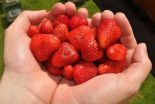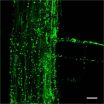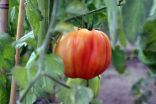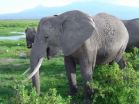(Press-News.org) An experiment has shown that strawberry extract added to skin cell cultures acts as a protector against ultraviolet radiation as well as increasing its viability and reducing damage to DNA. Developed by a team of Italian and Spanish researchers, the study opens the door to the creation of photoprotective cream made from strawberries.
"We have verified the protecting effect of strawberry extract against damage to skins cells caused by UVA rays," as explained to SINC by Maurizio Battino, researcher at the Università Politecnica delle Marche in Italy and lead author of the jointly Spanish and Italian study. The results are published in the 'Journal of Agricultural Food Chemistry'.
The team prepared human skin cell cultures (fibroblasts) and added strawberry extract in different concentrations (0.05, 0.25 and 0.5 mg/ml), the only exception being the control extract. Using ultraviolet light, the samples were then exposed to a dose "equivalent to 90 minutes of midday summer sun in the French Riviera."
Data confirm that the strawberry extract, especially at a concentration of 0.5 mg/ml, displays photoprotective properties in those fibroblasts exposed to UVA radiation, it increases cell survival and viability and decreases damage in the DNA when compared with control cells.
"These aspects are of great importance as they provide protection for cell lines subject to conditions that can provoke cancer and other skin-related inflammatory and degenerative illnesses," outlines Battino.
The researcher recognises that this is the "first step in determining the beneficial effects of strawberries in our diet or as a possible compound source for 'food integrators' or cosmetics for instance."
The redness of anthocyanins
But what molecules give strawberries their photoprotective properties? Scientists suspect that it could be the anthocyanins, which are pigments that give leaves, flowers and fruits their red colour. Analyses have confirmed that extracts are rich in such substances.
"These compounds have important anti-inflammatory, antioxidant and anti-tumour properties and are capable of modulating enzymatic processes," explains another of the authors, Sara Tulipani from the University of Barcelona. She adds that "we have not yet found a direct relationship between their presence and photoprotective properties."
"At the moment the results act as the basis for future studies evaluating the 'bioavailability' and 'bioactivity' of anthocyanins in the dermis and epidermis layers of the human skin, whether by adding them to formulations for external use or by ingesting the fruit itself," states Tulipani.
Also made up of researchers from the Universities of Salamanca and Granada, in its previous works the team had already demonstrated that strawberries (Fragaria x ananassa) strengthen the red bloods cells and protect the stomach from the effects of alcohol.
INFORMATION:
References:
Francesca Giampieri, Josè M. Alvarez-Suarez, Sara Tulipani, Ana M. Gonzàles-Paramàs, Celestino Santos-Buelga, Stefano Bompadre, JoséL. Quiles, Bruno Mezzetti, Maurizio Battino. "Photoprotective Potential of Strawberry (Fragaria × ananassa) Extract against UV-A Irradiation Damage on Human Fibroblasts". Journal of Agricultural Food Chemistry 60 (9): 2322-7, 2012.
Strawberry extract protects against UVA rays
2012-08-03
ELSE PRESS RELEASES FROM THIS DATE:
How the cell swallows
2012-08-03
VIDEO:
Scientists at EMBL have combined the power of two kinds of microscope to produce a three-dimensional movie of how cells ‘swallow’ nutrients and other molecules by engulfing them. The study...
Click here for more information.
Scientists at the European Molecular Biology Laboratory (EMBL) in Heidelberg, Germany, have combined the power of two kinds of microscope to produce a 3-dimensional movie of how cells 'swallow' nutrients and other molecules by engulfing them. The ...
Bacterial community inside the plant root
2012-08-03
This press release is available in German.Soil is the most species-rich microbial ecosystem in the world. From this incredible diversity, plants specifically choose certain species, give them access to the root and so host a unique, carefully selected bacterial community from which they then benefit in a variety of ways. To achieve this, the plant's immune system must be able to tell which of these bacteria are friends and which foes. Researchers from the Max Planck Institute for Plant Breeding Research in Cologne and the Max Planck Institute for Marine Microbiology in ...
Ethylene of no effect -- why peppers do not mature after picking
2012-08-03
This press release is available in German.Tomato breeders scored a coup several years ago when they identified tomatoes with a genetic defect that made the fruits mature very slowly, even under the influence of the phytohormone ethylene. Traders and growers were delighted as it gave them more time to transport the crop, initially still green, from where it was harvested to where it would be sold. At the stores, the tomatoes could then be treated with ethylene to bring them to maturity. Other fruits, like peppers, grapes and strawberries, generally do not mature after picking; ...
Mystery of elephant infrasounds revealed
2012-08-03
Elephants can communicate using very low frequency sounds, with pitches below the range of human hearing. These low-frequency sounds, termed "infrasounds", can travel several kilometers, and provide elephants with a "private" communication channel that plays an important role in elephants' complex social life. Their frequencies are as low as the lowest notes of a pipe organ.
Although the sounds themselves have been studied for many years, it has remained unclear exactly how elephant infrasounds are made. One possibility, favored by some scientists, is that the elephants ...
MAK value lowered for chlorinated biphenyls
2012-08-03
This press release is available in German.Chlorinated biphenyls (PCBs) are a group of substances for which the 2012 List of MAK and BAT Values submitted by the Senate Commission for the Investigation of Health Hazards of Chemical Compounds in the Work Area of the Deutsche Forschungsgemeinschaft (DFG, German Research Foundation) specifies new, and in this case, significantly lower values than previously recommended. The current list, which was presented to the German Federal Minister of Labour and Social Affairs as in every year, and which is the basis for legislation on ...
NUS researchers identify a novel double-stranded DNA structure
2012-08-03
Contact: Tsueyling Yong
sciytl@nus.edu.sg
65-651-67874
Carolyn Fong
Carolyn@nus.edu.sg
65-6516-5399
National University of Singapore
NUS researchers identify a novel double-stranded DNA structure
Researchers' findings address a scientific debate that had lasted for 16 years over the existence of a double-stranded DNA structure
Double-stranded DNA has often been described as a right-handed helical structure, known as B-DNA. To perform its multiple functions, double-stranded DNA has multiple structures depending on conditions. For example, the melted DNA ...
People with allergies may have lower risk of brain tumors
2012-08-03
COLUMBUS, Ohio - New research adds to the growing body of evidence suggesting that there's a link between allergies and reduced risk of a serious type of cancer that starts in the brain. This study suggests the reduced risk is stronger among women than men, although men with certain allergy profiles also have a lower tumor risk.
The study also strengthens scientists' belief that something about having allergies or a related factor lowers the risk for this cancer. Because these tumors, called glioma, have the potential to suppress the immune system to allow them to grow, ...
MDC researchers develop new approach to treat acute liver failure
2012-08-03
Acute liver failure is a life-threatening disease, characterized by a sudden, massive death of liver cells. Unfortunately, few treatment options exist, especially for advanced-stage liver failure. As a last resort a liver transplant may be the only remaining option. Now the physician Dr. Junfeng An of the Max Delbrück Center for Molecular Medicine (MDC) Berlin-Buch and Dr. Stefan Donath, a specialist in internal medicine and cardiology, also of the MDC and Helios Klinikum Berlin-Buch, have developed a new treatment approach based on a mouse model. In their current study ...
Major step taken towards 'unbreakable' message exchange
2012-08-03
Single particles of light, also known as photons, have been produced and implemented into a quantum key distribution (QKD) link, paving the way for unbreakable communication networks.
The results of the experiment, undertaken by a close collaboration of researchers based in Wuerzburg, Munich and Stuttgart, have been published today, Thursday 2 August, in the Institute of Physics and German Physical Society's New Journal of Physics.
The single photons were produced using two devices made of semiconductor nanostructures that emitted a photon each time they were excited ...
Students with strong hearts and lungs may make better grades, study finds
2012-08-03
ORLANDO, Fla. -- Having a healthy heart and lungs may be one of the most important factors for middle school students to make good grades in math and reading, according to findings presented at the American Psychological Association's 120th Annual Convention.
"Cardiorespiratory fitness was the only factor that we consistently found to have an impact on both boys' and girls' grades on reading and math tests," said study co-author Trent A. Petrie, PhD, professor of psychology and director of the Center for Sport Psychology at the University of North Texas. "This provides ...




